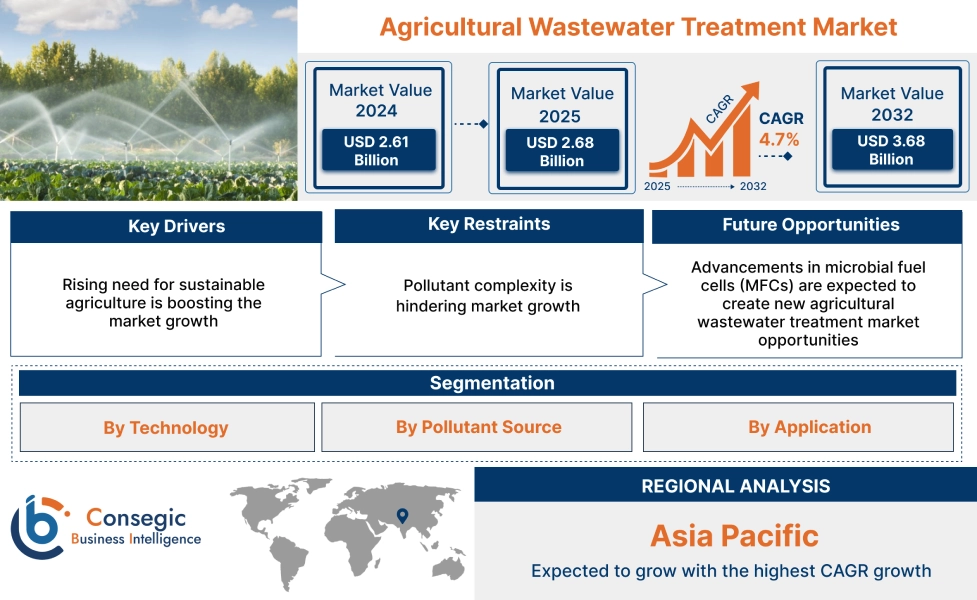Agricultural Wastewater Treatment Market Size:
Agricultural Wastewater Treatment Market size is estimated to reach over USD 3.68 Billion by 2032 from a value of USD 2.61 Billion in 2024 and is projected to grow by USD 2.68 Billion in 2025, growing at a CAGR of 4.7% from 2025 to 2032.
Agricultural Wastewater Treatment Market Scope & Overview:
Agricultural wastewater treatment involves managing runoff and discharges from farming operations to prevent pollution. This treatment aims to reduce the contamination of water resources by animal slurry, chemicals, and other pollutants. The process typically involves several stages, to remove solids, break down organic waste, and further purify the water. Moreover, treated wastewater provides essential nutrients including nitrogen, phosphorus, and potassium for plant growth, reducing the need for chemical fertilizers. Wastewater treatment helps ensure that discharged wastewater meets environmental standards and reduces the risk of water pollution.
How is AI Impacting the Agricultural Wastewater Treatment Market?
AI is playing an important role in improving the agricultural wastewater treatment market by making processes more accurate, efficient, and sustainable. With advanced models, AI can predict key water quality indicators such as pH, nitrogen, and suspended solids with high precision. This allows operators to monitor treatment systems in real time and make adjustments quickly, reducing dependence on manual testing and lowering operational costs. AI also helps forecast effluent quality, ensuring that treated water meets safety standards for reuse in irrigation. By optimizing performance and minimizing environmental risks, AI-driven solutions are helping agriculture manage water resources more effectively and move toward more sustainable practices.
Agricultural Wastewater Treatment Market Dynamics - (DRO) :
Key Drivers:
Rising need for sustainable agriculture is boosting the market growth
Treating and reusing agricultural wastewater is a key component of sustainable agriculture, reducing freshwater demand and improving soil health while promoting eco-friendly food production. This approach not only conserves natural resources but also mitigates the environmental impact of traditional agricultural practices. Treated wastewater often contains essential nutrients like nitrogen and phosphorus, which can serve as a valuable fertilizer, enhancing soil fertility and improving plant growth. By reusing wastewater for irrigation, the amount of wastewater discharged into waterways is reduced, helping to protect water quality and aquatic ecosystems.
- For instance, in April 2025, Mott Corporation partnered with a large U.S. dairy farm operation. The agreement of USD 40 million was signed to treat over two million gallons of wastewater per day using advanced filtration systems.
Thus, the aforementioned factors are boosting the adoption of wastewater treatment, in turn driving the agricultural wastewater treatment market growth.
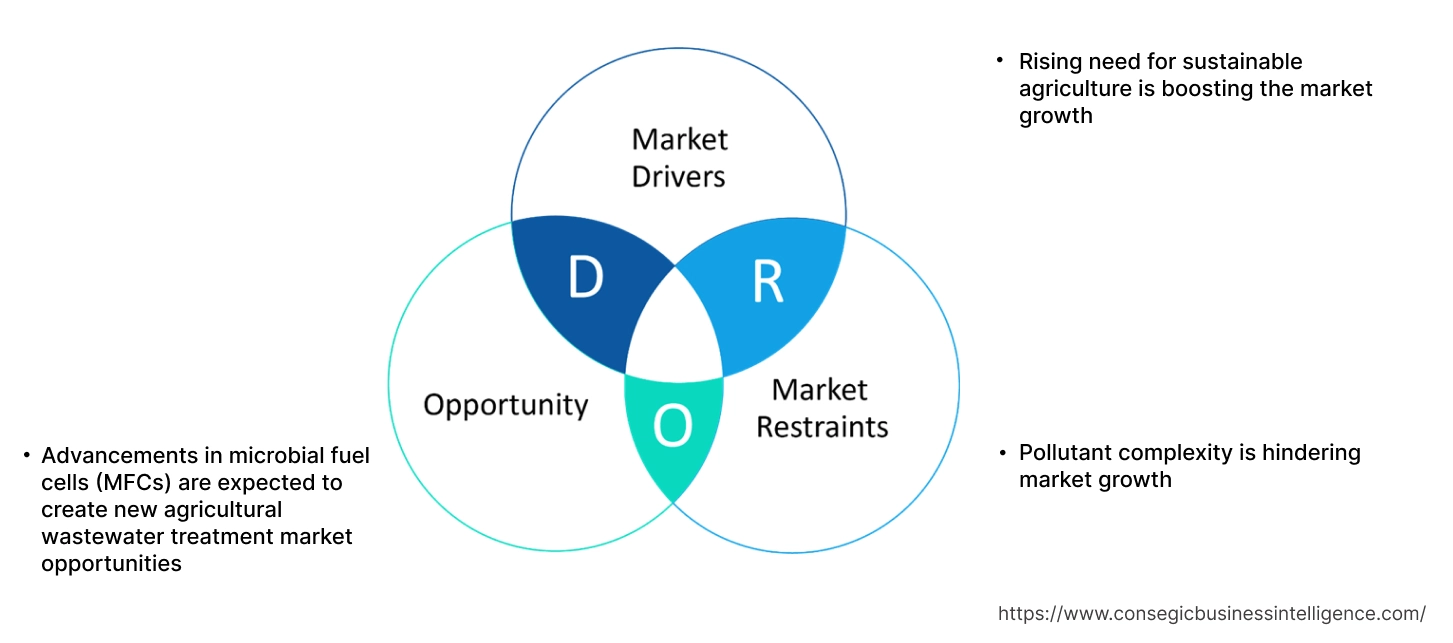
Key Restraints :
Pollutant complexity is hindering market growth
Agricultural wastewater treatment faces challenges due to the complexity of pollutants, including a mix of organic matter, nutrients, pesticides, and heavy metals. These pollutants harm the environment and human health if not properly managed. Effective treatment requires a combination of technologies and approaches to address the specific characteristics of the wastewater and ensure safe reuse.
Additionally, the presence of multiple pollutants in varying concentrations can make it difficult to design effective treatment systems. Thus, the market analysis shows that the aforementioned factors are restraining the agricultural wastewater treatment market demand.
Future Opportunities :
Advancements in microbial fuel cells (MFCs) are expected to create new agricultural wastewater treatment market opportunities
MFCs use microorganisms to convert the organic matter in wastewater into electricity, effectively purifying the water and producing a renewable energy source. This technology is particularly beneficial for agricultural applications where wastewater treatment and energy generation are both critical.
Moreover, microorganisms in the MFC anode chamber break down the organic pollutants in agricultural wastewater, generating electrons. These electrons flow through an external circuit, producing electricity. The treated water, with reduced organic load, is used for irrigation or other purposes. Therefore, the ongoing advancements related to microbial fuel cells for wastewater treatment are projected to drive agricultural wastewater treatment market opportunities during the forecast period.
Agricultural Wastewater Treatment Market Segmental Analysis :
By Technology:
Based on the technology, the market is segmented into physical solutions, chemical solutions, and biological solutions.
Trends in the Technology:
- Rising trend in the adoption of physical solutions for removing suspended solids and larger particles through processes including screening, sedimentation, and filtration.
- Increasing adoption of physical solutions including grit removal, membrane filtration, adsorption, and air floatation is boosting the agricultural wastewater treatment market size.
The chemical solutions segment accounted for the largest revenue share of 65.08% in the market in 2024.
- Chemical solutions are crucial in removing contaminants including suspended solids, pathogens, and nutrients, and include coagulants, flocculants, and disinfectants.
- Coagulants and flocculants are used to destabilize and clump together small particles, making them easier to remove through sedimentation or filtration.
- Disinfectants including chlorine, ozone, and hydrogen peroxide are used to kill or inactivate harmful pathogens in the wastewater.
- Moreover, chemical precipitation and other processes are used to remove heavy metals like lead, cadmium, and mercury.
- Therefore, the market analysis depicts that the widespread adoption of chemical solutions is boosting the agricultural wastewater treatment market growth.
The biological solutions segment is expected to register the fastest CAGR during the forecast period.
- Biological solutions use microorganisms including bacteria to degrade pollutants. These methods are often used in combination with other techniques to effectively remove organic matter and nutrients from wastewater.
- Activated sludge processes, trickling filters, and constructed wetlands are examples of biological methods used in wastewater treatment in agriculture.
- The activated sludge process is an aerobic process that uses microorganisms to break down organic matter in wastewater, which is then separated as sludge.
- Constructed wetlands are natural or artificial wetlands that utilize plants and microorganisms to filter and purify wastewater.
- Thus, the agricultural wastewater treatment market analysis shows that the rising demand for biological solutions is expected to boost the agricultural wastewater treatment market trends during the forecast period.
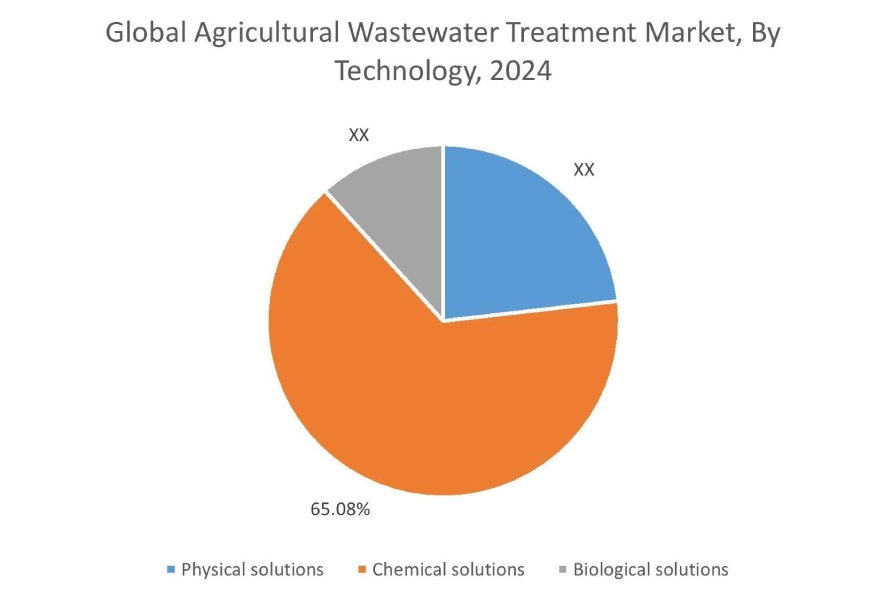
By Pollutant Source:
Based on the pollutant source, the market is segmented into point source and non-point source.
Trends in the Pollutant Source:
- Rising demand for wastewater treatment for point sources for facilitating improved soil fertility, reduced reliance on freshwater sources, and potential cost savings for farmers is boosting the agricultural wastewater treatment market size.
- Increasing trend in adoption of wastewater treatment solutions for non-point sources for reduced pollution, resource conservation, and potential economic gains.
The non-point source segment accounted for the largest revenue share in the agricultural wastewater treatment market share in 2024 and it is expected to register the fastest CAGR during the forecast period.
- Non-point source pollution is defined as water pollution originating from a variety of diffuse sources, such as agricultural runoff or windblown debris.
- Runoff from agricultural land, including excess water from irrigation and rainfall, carries pollutants including fertilizersand pesticides.
- Excess nutrients lead to algal blooms, oxygen depletion, and impaired water quality. Some pollutants can seep into groundwater, contaminating drinking water supplies.
- Non-point source pollution can significantly impair water quality, making it unsuitable for drinking, recreation, and aquatic life.
- Thus, the market analysis shows that the rising wastewater from non-point sources is boosting the agricultural wastewater treatment market trends during the forecast period.
By Application:
Based on the application, the market is segmented into farmland runoff, farm wastewater, and others.
Trends in the Application:
- Rising need for agricultural wastewater treatment for managing runoff and effluent from farms, including animal operations and crop processing is boosting the agricultural wastewater treatment market demand.
- Increasing trend in the adoption of treated wastewater for reuse in irrigation or other agricultural purposes is driving the market.
The farmland runoff segment accounted for the largest revenue share in the agricultural wastewater treatment market share in 2024 and is expected to register the fastest CAGR during the forecast period.
- Wastewater treatment of farmland runoff aims to manage and reduce pollution from agricultural activities, which include contaminants like fertilizers, pesticides, and animal waste.
- Constructed wetlands are man-made wetlands that are designed to effectively remove pollutants from runoff water. They utilize natural processes including plant uptake, microbial activity, and sedimentation to reduce contaminants.
- Biological treatments including microalgae and other microorganisms are used to absorb and break down pollutants in runoff water. Microalgae are particularly effective at removing nutrients like nitrogen and phosphorus.
- Therefore, the market analysis depicts that the aforementioned factors are boosting the agricultural wastewater treatment market expansion.
Regional Analysis:
The regions covered are North America, Europe, Asia Pacific, the Middle East and Africa, and Latin America.
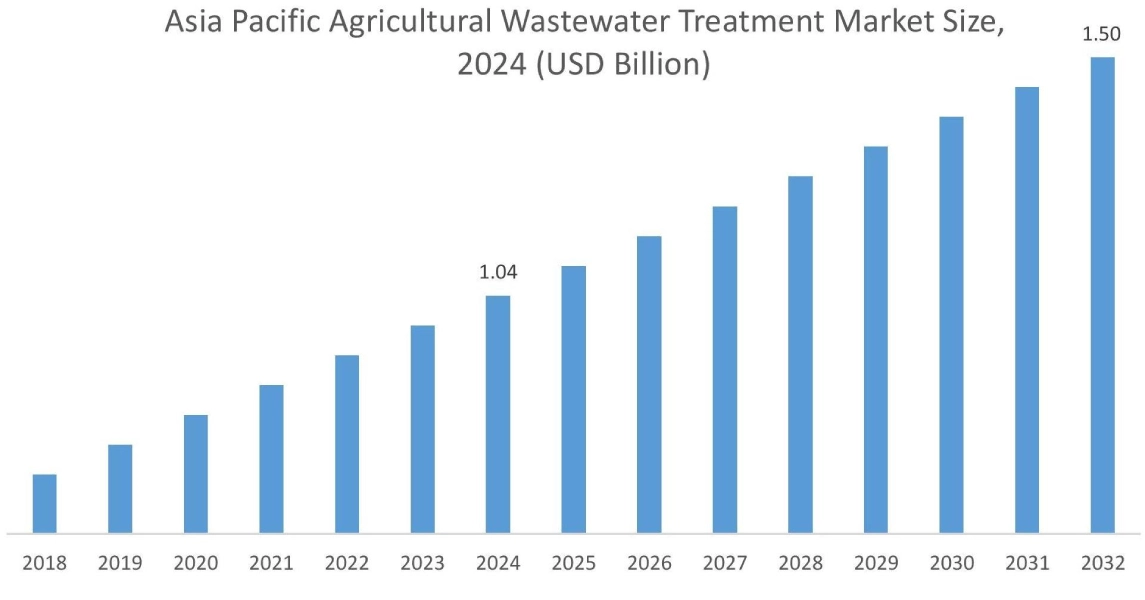
Asia Pacific region was valued at USD 1.04 Billion in 2024. Moreover, it is projected to grow by USD 1.07 Billion in 2025 and reach over USD 1.50 Billion by 2032. Out of this, China accounted for the maximum revenue share of 31.94%. The market in the region is primarily driven by the growing agriculture industry. The development of cropped and barren lands leads to agriculture pollution, in turn boosting the agricultural wastewater treatment market expansion in the region.
- For instance, in July 2024, the Ministry of Agriculture and Farmers Welfare, Indiastated that the total cropped area increased from 201.18 million hectares in 2020-21 to 219.16 million hectares in 2021-22.
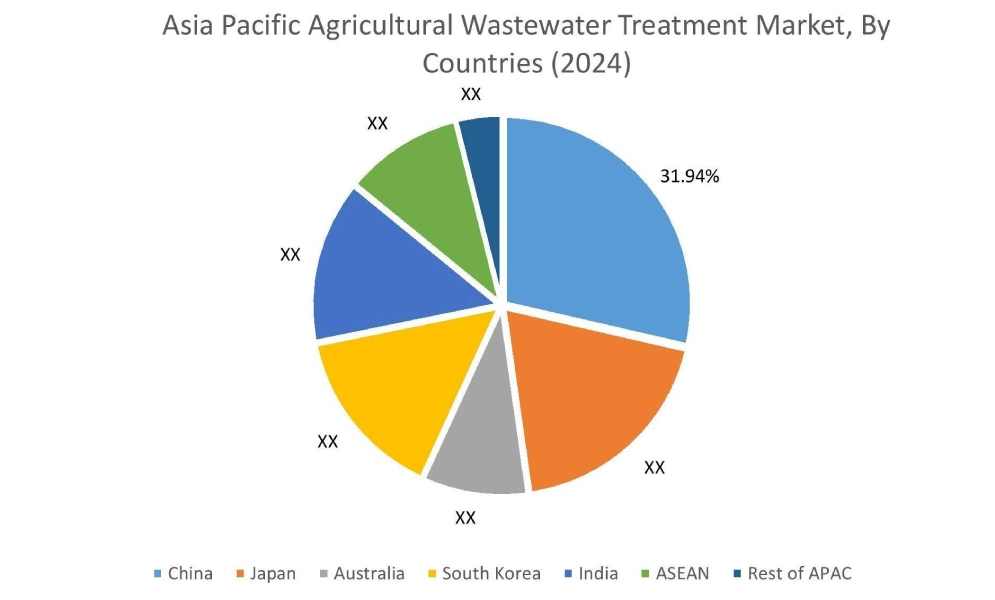
North America is estimated to reach over USD 0.79 Billion by 2032 from a value of USD 0.58 Billion in 2024 and is projected to grow by USD 0.60 Billion in 2025. The market in the region focuses on minimizing environmental impact and maximizing resource recovery associated with agricultural operations. Additionally, there is a growing focus on wastewater reuse, particularly in arid regions, where treated wastewater is used for irrigation. The above factors are driving the market in North America.
In addition, the agricultural wastewater treatment market analysis shows that in Europe, the treatment and reuse of wastewater for agricultural irrigation is becoming increasingly important due to water scarcity and the need for sustainable water management, thereby, driving the market demand. In Latin America, the Middle East, and Africa, the market growth is driven by rising agricultural activities that require the utilization of simple, low-cost methods such as wastewater treatment ponds. These methods are crucial for addressing water scarcity and enhancing food security in the regions.
Top Key Players & Market Share Insights:
The agricultural wastewater treatment industry is highly competitive with major players providing solutions and services to the national and international markets. Key players are adopting several strategies in research and development (R&D), product innovation, and end-user launches to hold a strong position in the global agricultural wastewater treatment market. Key players in the agricultural wastewater treatment industry include -
- AECOM(US)
- Aquatech International LLC(US)
- Louis Berger (US)
- Nouryon (Netherlands)
- Organo Corporation (Japan)
- BASF SE(Germany)
- DuPont (US)
- Evoqua Water Technologies LLC (US)
- IDE Technologies (Israel)
- Lindsay Corporation (US)
Agricultural Wastewater Treatment Market Report Insights :
| Report Attributes | Report Details |
| Study Timeline | 2019-2032 |
| Market Size in 2032 | USD 3.68 Billion |
| CAGR (2025-2032) | 4.7% |
| By Technology |
|
| By Pollutant Source |
|
| By Application |
|
| By Region |
|
| Key Players |
|
| North America | U.S. Canada Mexico |
| Europe | U.K. Germany France Spain Italy Russia Benelux Rest of Europe |
| APAC | China South Korea Japan India Australia ASEAN Rest of Asia-Pacific |
| Middle East and Africa | GCC Turkey South Africa Rest of MEA |
| LATAM | Brazil Argentina Chile Rest of LATAM |
| Report Coverage |
|
Key Questions Answered in the Report
How big is the agricultural wastewater treatment market? +
Agricultural Wastewater Treatment Market size is estimated to reach over USD 3.68 Billion by 2032 from a value of USD 2.61 Billion in 2024 and is projected to grow by USD 2.68 Billion in 2025, growing at a CAGR of 4.7% from 2025 to 2032.
What are the major segments covered in the agricultural wastewater treatment market report? +
The segments covered in the report are technology, pollutant source, application, and region.
Which region holds the largest revenue share in 2024 in the agricultural wastewater treatment market? +
Asia Pacific holds the largest revenue share in the agricultural wastewater treatment market in 2024.
Who are the major key players in the agricultural wastewater treatment market? +
The major key players in the market are AECOM (US), Aquatech International LLC (US), BASF SE (Germany), DuPont (US), Evoqua Water Technologies LLC (US), IDE Technologies (Israel), Lindsay Corporation (US), Louis Berger (US), Nouryon (Netherlands), and Organo Corporation (Japan).
